Return to Ancest4 Jacob Conrad Genealogy.
Return to Ancest4 Main Page.
Check the new Hall of Shame list of institutions supporting Emory Conrad Malick false narrative
Return to Ancest4 Jacob Conrad Genealogy.
Return to Ancest4 Main Page.
Check the new Hall of Shame list of institutions supporting Emory Conrad Malick false narrative
Welcome to the Emory Conrad Malick research page! During research of Emory for our Conrad family tree, we discovered the interesting story of how Emory went from local farm hand and carpenter to an aviation pioneer just 7 years after the Wright Brothers demonstrated the possibility of powered flight in 1903. He completed his aviation training in 1912 and brought aviation to Central and Southeast Pennsylvania. As a both a genealogist and a private pilot myself, I found this to be a fascinating story for our family to pass on.
Following is a summary of Emory's early life, clippings showing documenting his aviation career, and some source material regarding the question of race about the claim that he was the "First Black Aviator".
Emory Conrad Malick was born 29 Dec 1881 in Lower Augusta Township, Northumberland County to Darius Malick and Susanna Conrad. The Malick and Conrad families had both been early pioneer families in the Pennsylvania German parts of Northumberland County since the late 1700's. Darius and Susan were married 7 Oct 1877. According to the 1880 census, Darius worked in a carriage shop was a house carpenter in 1900. It would seem that Emory could have learned mechanical and woodworking skills from his father Darius.
Emory's mother Susan Conrad Malick died 17 Dec 1887 leaving Darius with six young children. Emory was only six years old at the time. His father Darius then married Elizabeth Hummer in 1889 and with this wife had seven more children.
Because no 1890 census records survived a fire, Emory makes his first appearance in the 1900 census as a farm laborer in the home of George Miller, aged 18. In 1905-1909 he's listed in the Sunbury directory as a carpenter. He then shows up twice in 1910 once as a house carpenter in Philadelphia, 16 Apr 1910 and then again as a house carpenter at a hotel in Lancaster City. It would seem that Emory either maintained a room at both locations or he had just moved. At this time, rail service between Philadelphia, Lancaster, Harrisburg, and Sunbury would have provided ready transportation across Southeastern Pennsylvania.
Emory is listed as a communicant at St. Matthew's Evangelical Lutheran Church in Philadelphia for Easter 1910 and Jan 1st 1911. He also appears occasionally between 1922-29. In the Philadelphia city directory, Emory is listed as a carpenter 1910-1911. It seems that most of the time Emory relied on other occupations as a source of income. However, having mechanical and wood working skills would be very valuable in building and maintaining an aircraft.
In the 1920 census, despite his ongoing aviation exploits, Emory is listed as a farm laborer, aged 38, living at the home of Cottie Weiser in Lower Augusta Township, Northumberland County. It seems that then, as now, it's difficult to make enough money flying and Emory seems to have relied on his other skills to pay the bills.
It's important to realize that when Emory pursued his interest in aviation in 1911, the Wright Brothers had only first demonstrated powered flight seven years earlier in December 1903. Airplanes were not only difficult to find but expensive to learn to fly, purchase, and maintain.
Glenn Curtis, who was a competitor of the Wrights, started a flight school in 1910 at San Diego, California, and Emory had to find funding to not only get to California, but to pay for months worth of flying lessons. As can be seen by the early graduates, people from around the world were being sent here to learn how to fly.
Emory brought aviation back to Central Pennsylvania, where his aerial exploits, including occasional accidents, were regularly reported in the newspapers. He seems to have shifted his residence back-and-forth between Northumberland County and Philadelphia.
Note that early aerial navigation was difficult, often relying on visually identifying landmarks. Even early radio navigation was a long ways off, and flying in bad weather was dangerous and risky. The death of a passenger in 1928 seems to have been the point where Emory decided to exit aviation. He was lucky to have been able to survive his injuries from almost 20 years of flying in the earliest days of aviation.
Following is a timeline of newspaper and book clippings...
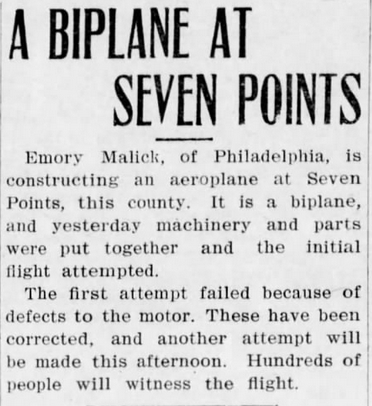
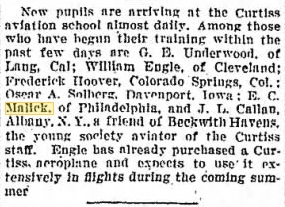

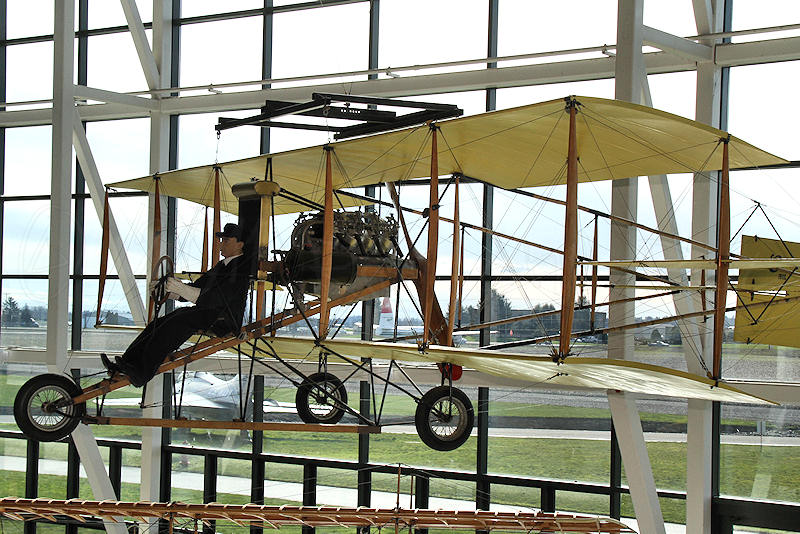
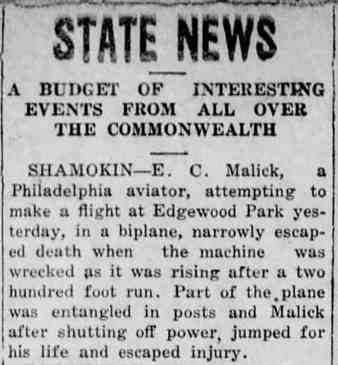
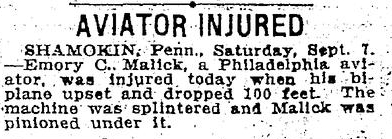

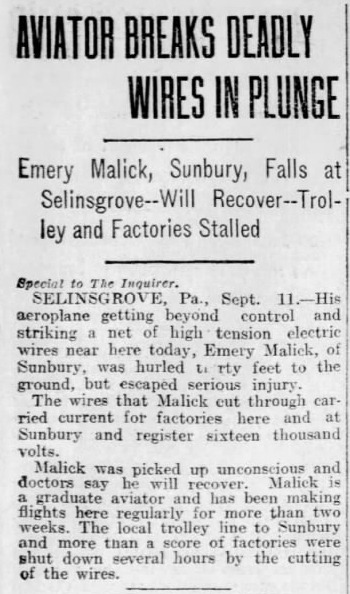
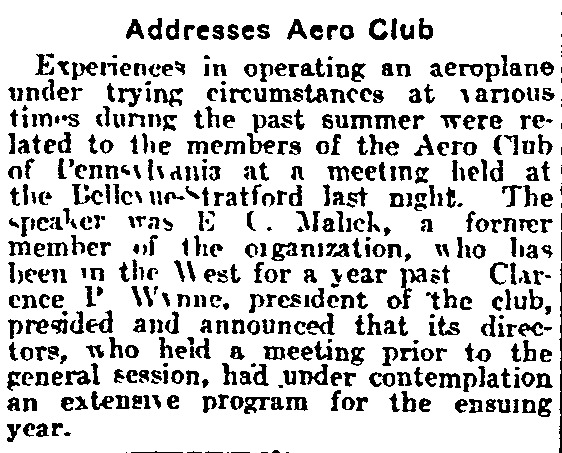
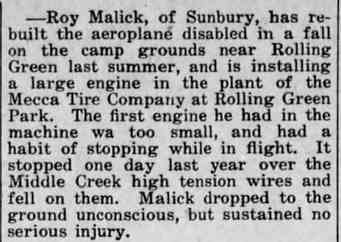
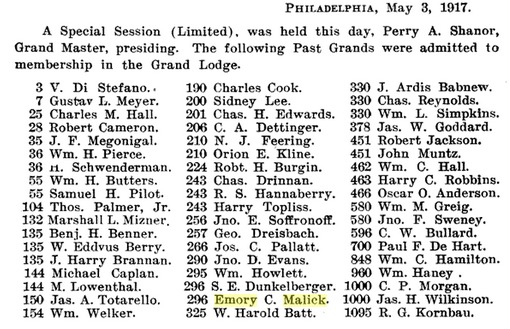

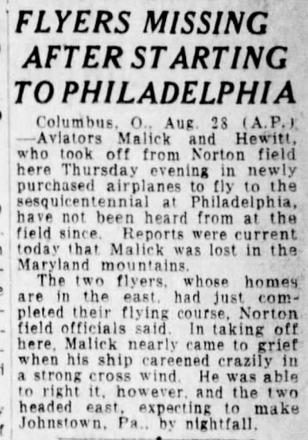
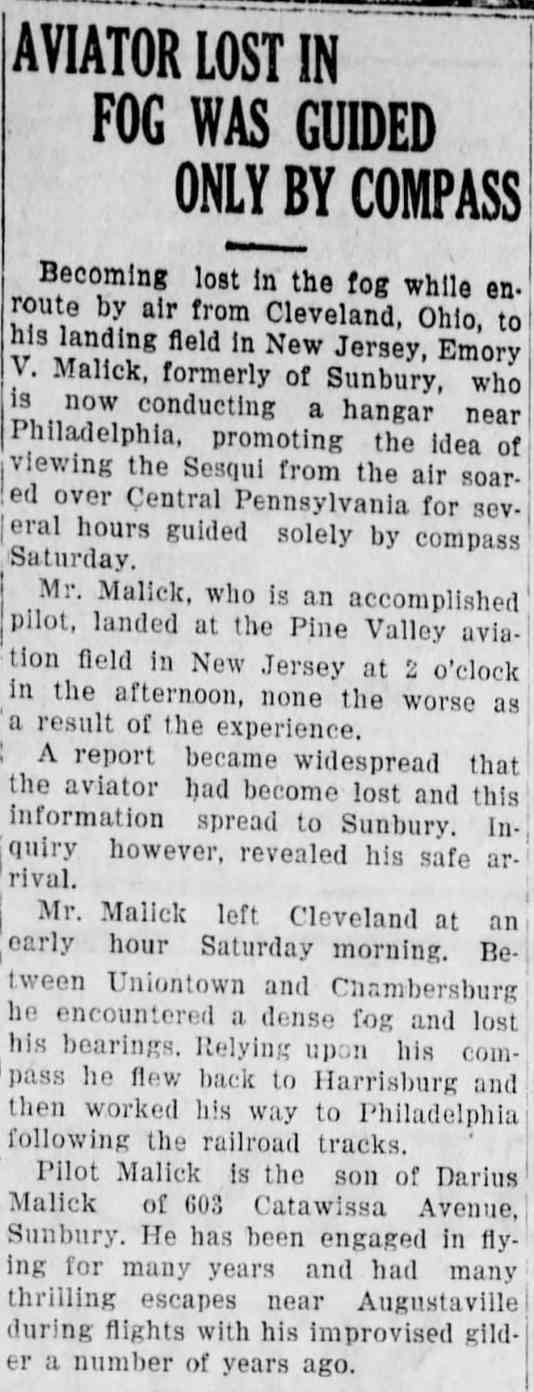

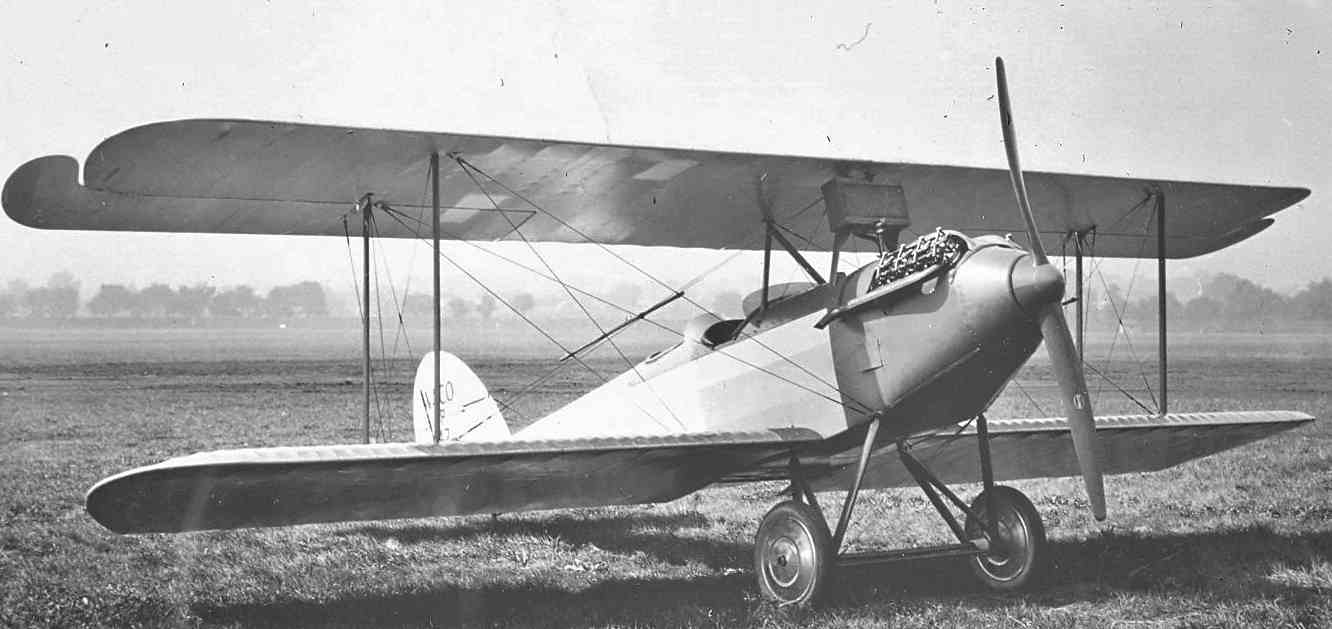
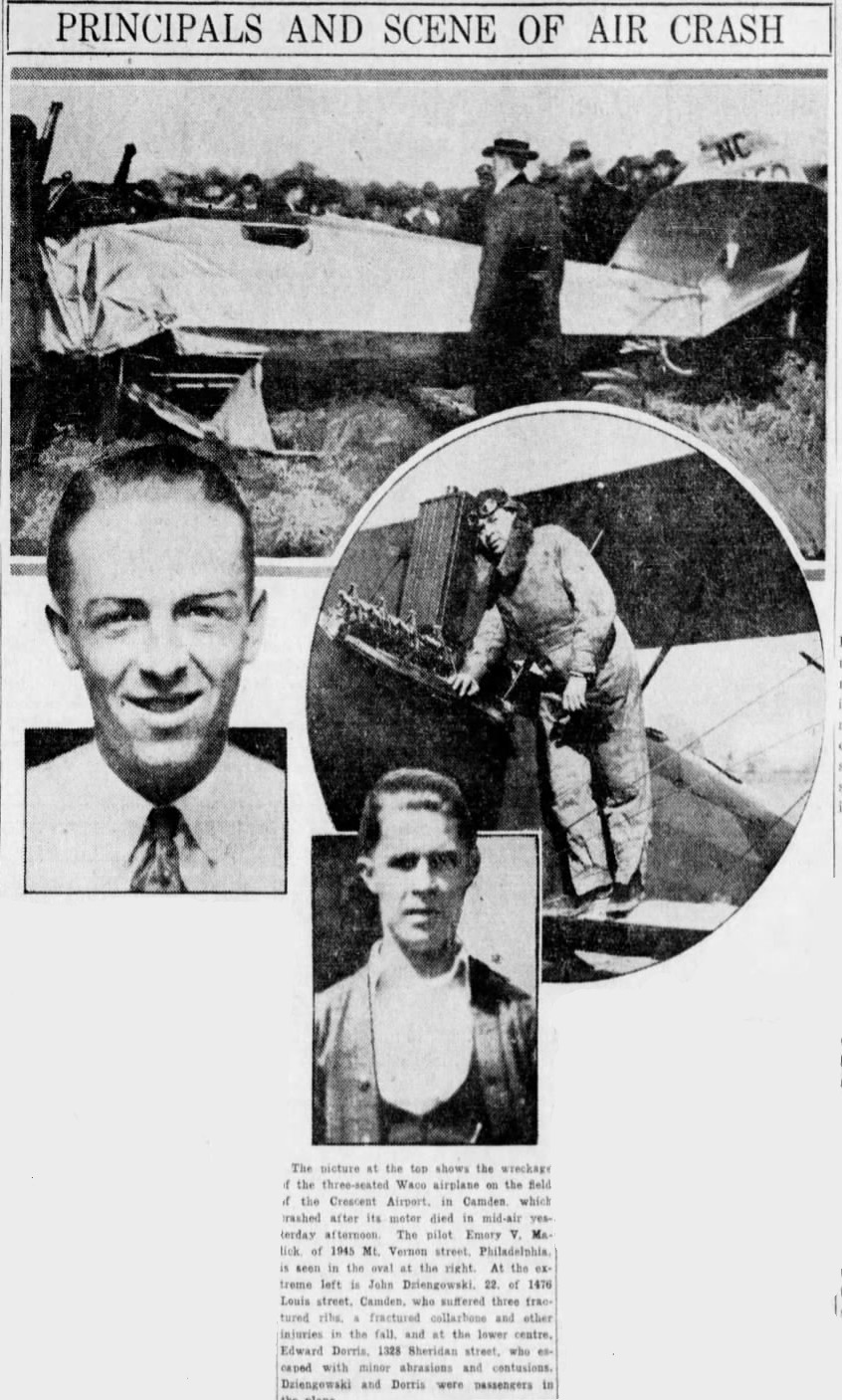
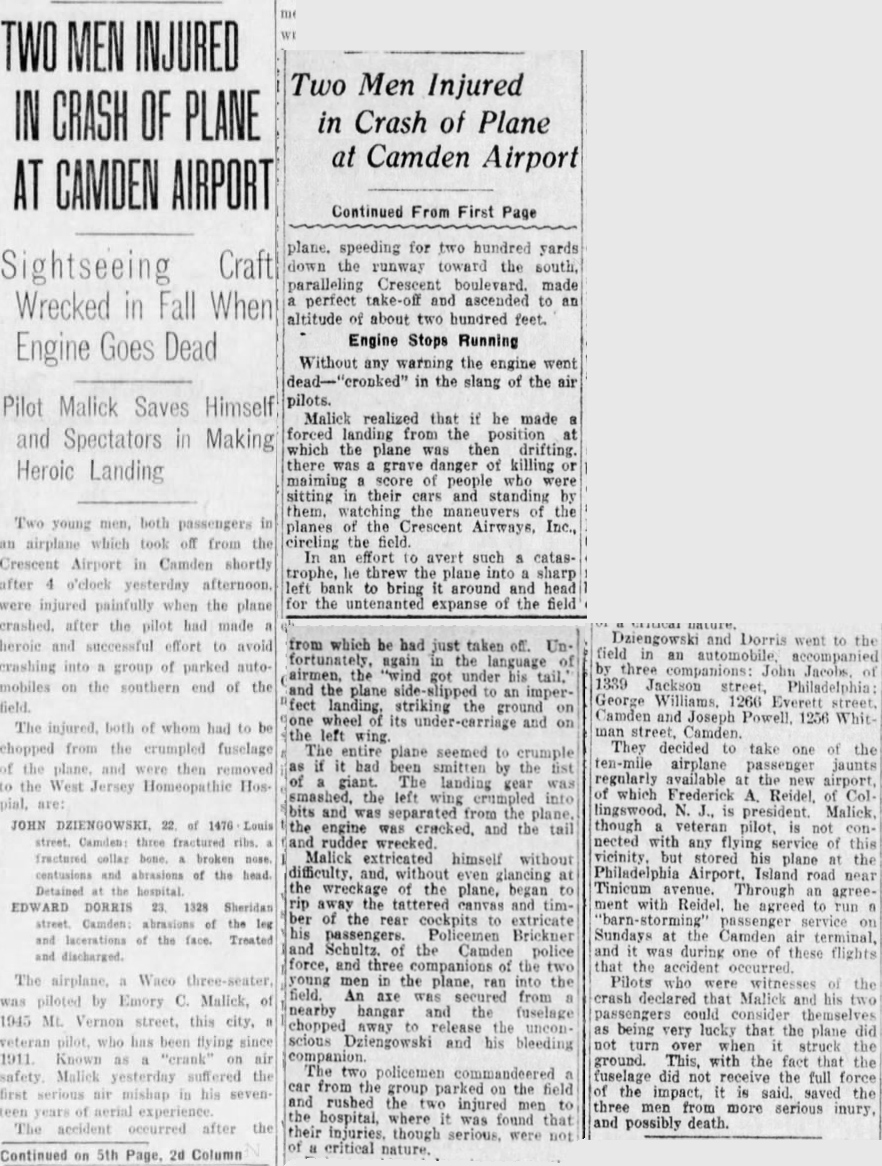

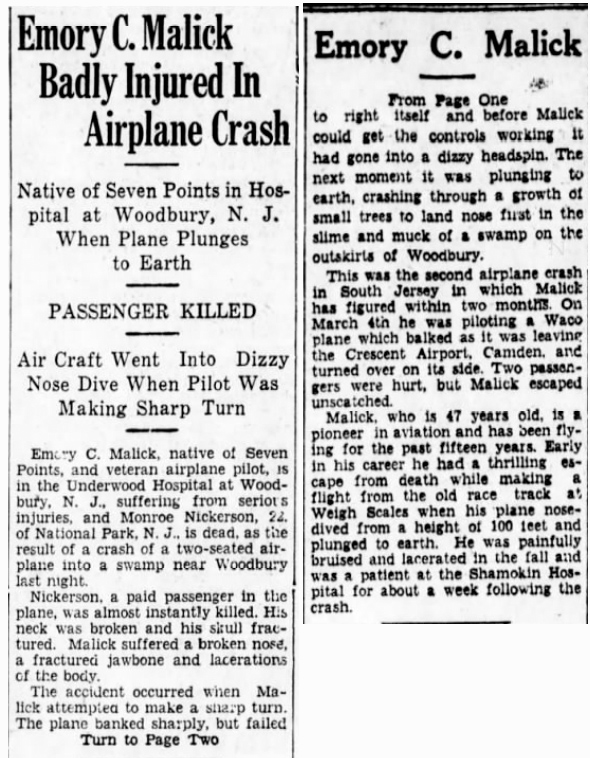
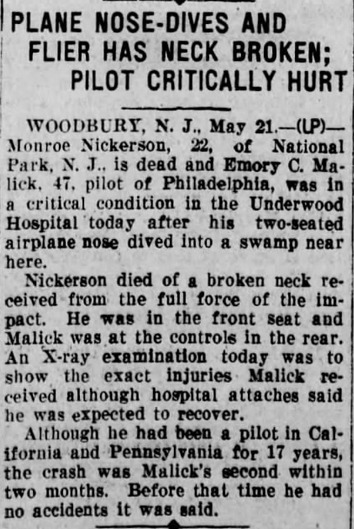
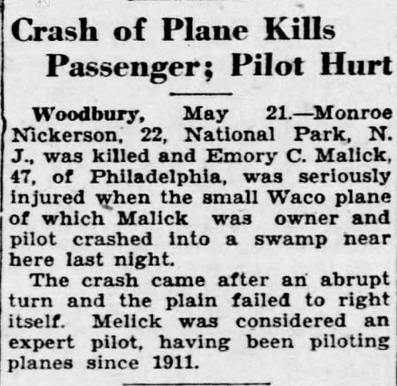

A controversy began when the Smithsonian Air & Space Magazine published an article in March 2011 entitled The Unrecognized First. The article shows that a descendant of Emory Malick found a picture of her great uncle and believed he looked black. Upon seeing his picture, the relatives said "Oh my God. He's black." and "this explains my brother's blond afro." The black-and-white picture shows a man with a cap covering his hair flying an early airplane. The article's picture closely matches a picture of Emory shown in an advertisement with the label "E C Malick" for the Curtiss flying school in 1912, seeming to confirm the identification of the individual in the photo. But nobody at the time of the article vetted the claim that Emory was actually black. No records were produced authenticating the claim and there was not even a claim of a family tradition of being black. In fact, the descendant innocently said, "I was never told about Emory or my mixed heritage."
That Emory was a pioneer aviator is not in doubt. There are plenty of contemporaneous documents showing his attendance at the Curtiss school, visiting his parents in Northumberland County, and performing aerial exhibitions in the area. His exploits are described in the local newspapers for approximately 19 years. But all contemporaneous records have shown that Emory and other members of the extended family were white. Of course, having the first black anything would be an honor for any family to claim, but it would need to be based on established facts to have any value.
The claim that Emory Malick was the First Black Aviator might have gone unchallenged if not for a book published in 2014 by black aviation historian, Guy E Franklin, entitled Emory Conrad Malick: A Closer Look. This book (purchase this if you're interested in the subject), Guy methodically outlines the case that Emory was actually white. He even included research on Emory's membership in the Odd Fellow's (an organization limited to white members at this time). Some of the original source material is depicted below.
Note that multiple contemporaneous documents show not only that Emory was white, but that he had a ruddy complexion, brown hair, and blue eyes. The class picture alone (with a hat covering his hair) would not prove that the written record is incorrect and that Emory was black (but pretending to be white). As seen below, Emory, his parents, grandparents, and other ancestors as well as siblings all self-identified as being white.
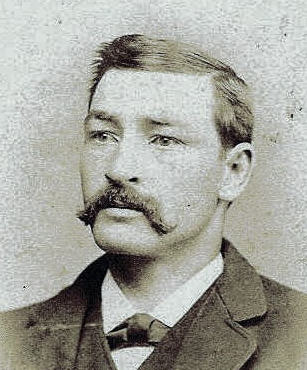
father Darius Malick | 
photo of Emory from San Diego History Center | 
photo of Emory from Smithsonian Air & Space | 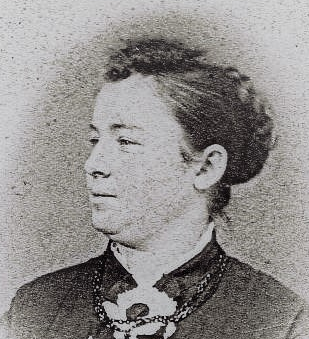
mother Susan Conrad |
If Emory were black, it's interesting that with all of the press coverage, nobody reporting at that time on his aerial exploits had brought up Emory being non-white. Other black aviators were celebrities because they were black!
Note that many Conrad/Malick descendants have had DNA testing done and we have yet to find any in this line that show African descent in the ethnicity report. While some African DNA could support this premise, the lack of African DNA, even in trace amounts, suggests that they are not of African descent. In particular, Mary Groce (the person making the claim that Emory was black) and also a descendant of Darius Malick and Susanna Conrad showed no African ancestry in an ancestry.com autosomal test. A cousin of Mary posted Mary Groce's public DNA profile on the Emory Conrad Malick - The Truth Behind The Myth Facebook page, a research page for those those interested in Emory Malick (of which Mary Groce is a member). Realize that a Great-Great-Great-Great-Great Grandparent would contribute 1/128th of a person's DNA (slightly less than 1%). This autosomal DNA test includes contributes < 1.0% in the trace section, and there are no trace African DNA markers detected.

above, ethnicity report for an ancestry autosomal DNA profile of a known descendant of Darius Malick and Susan Conrad
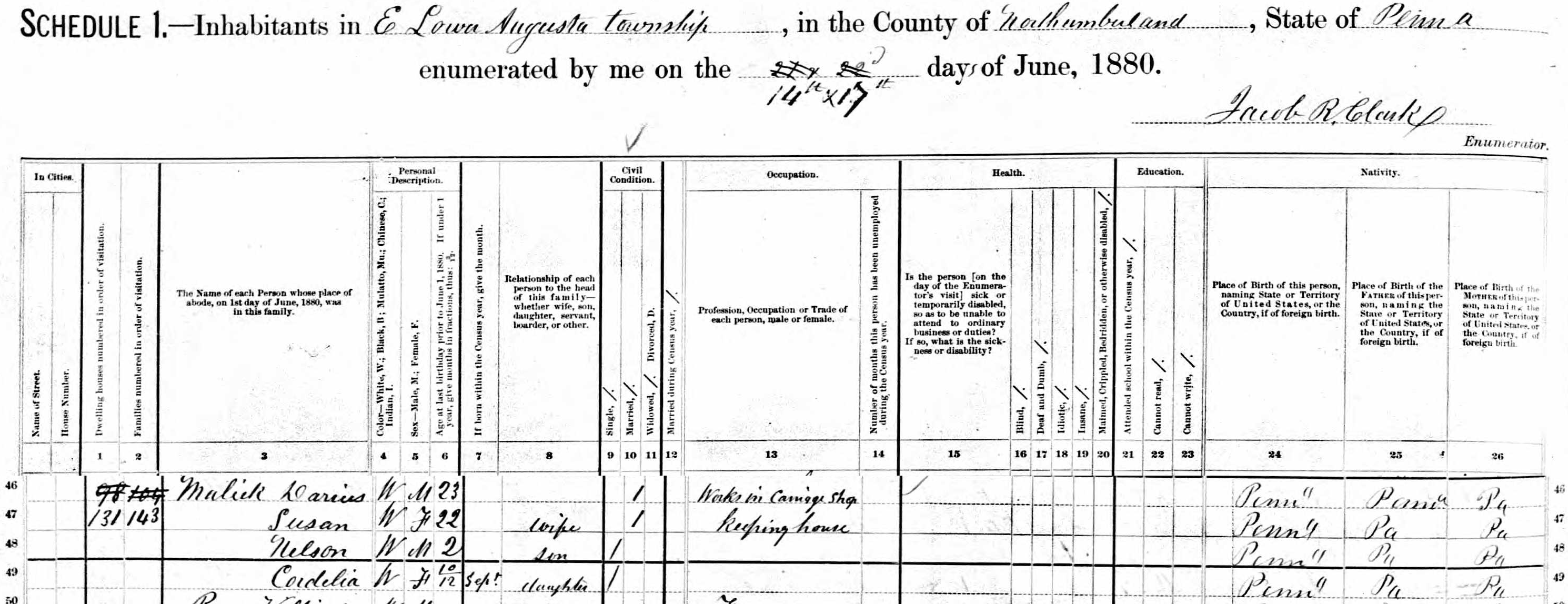




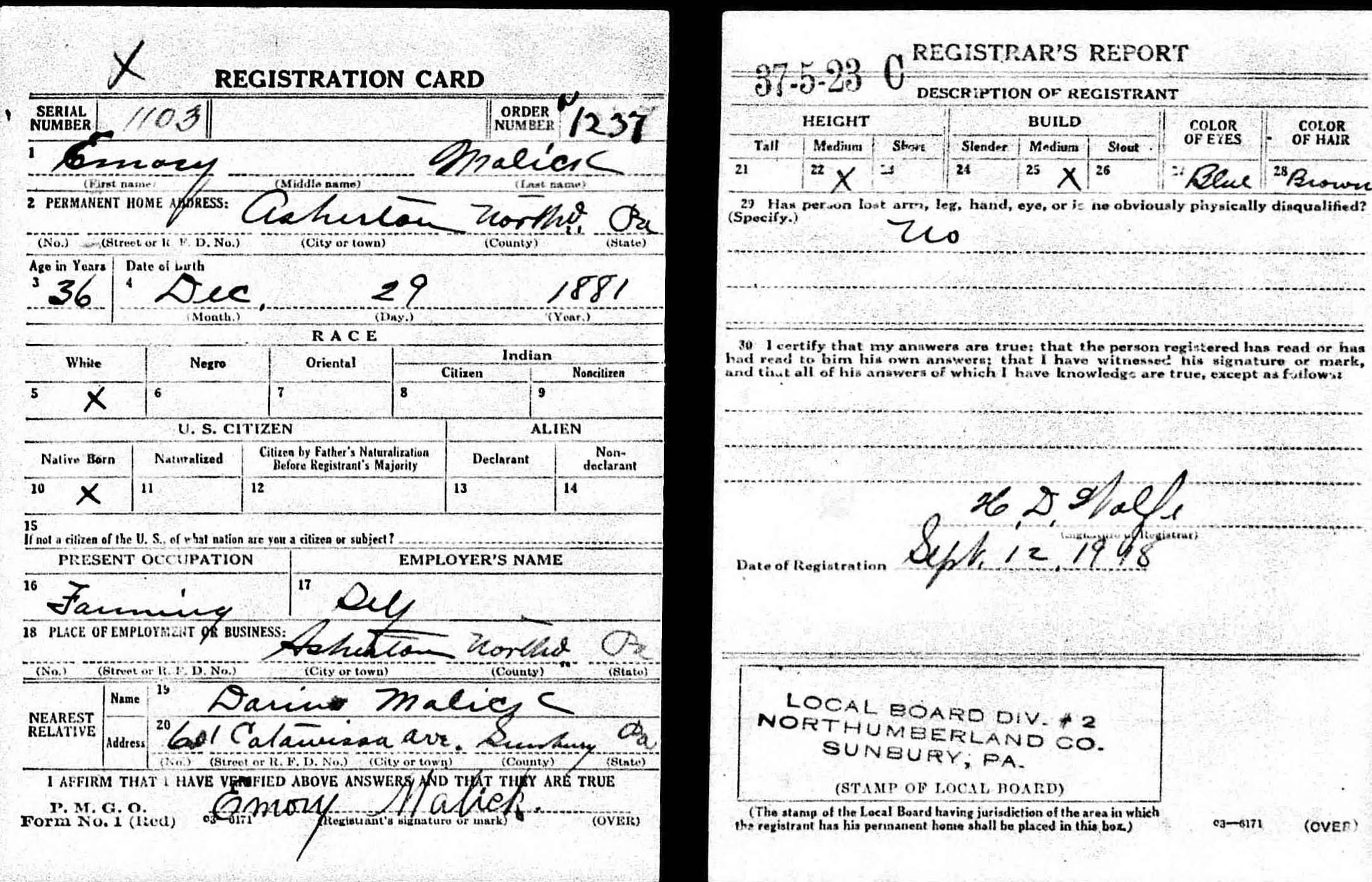
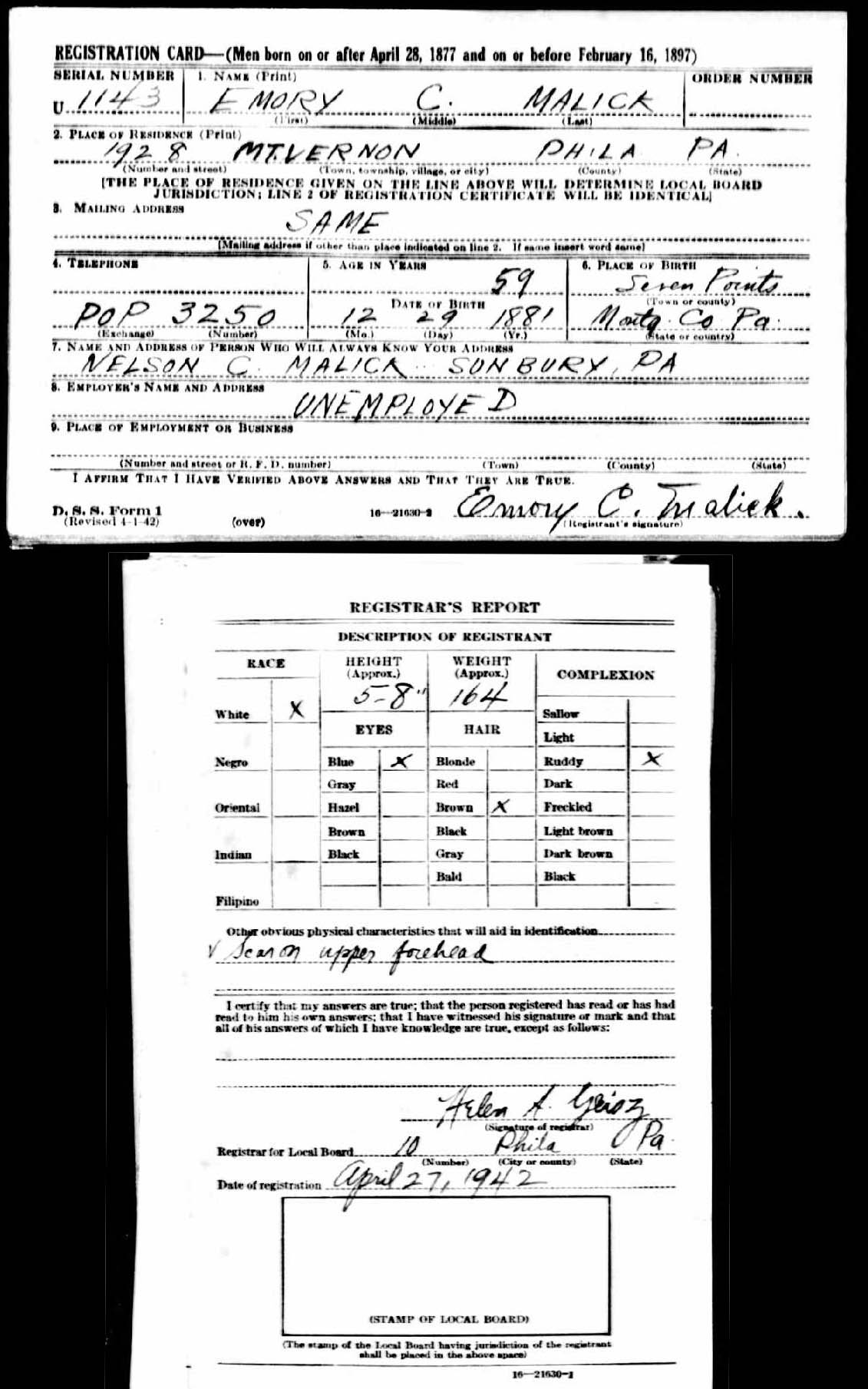
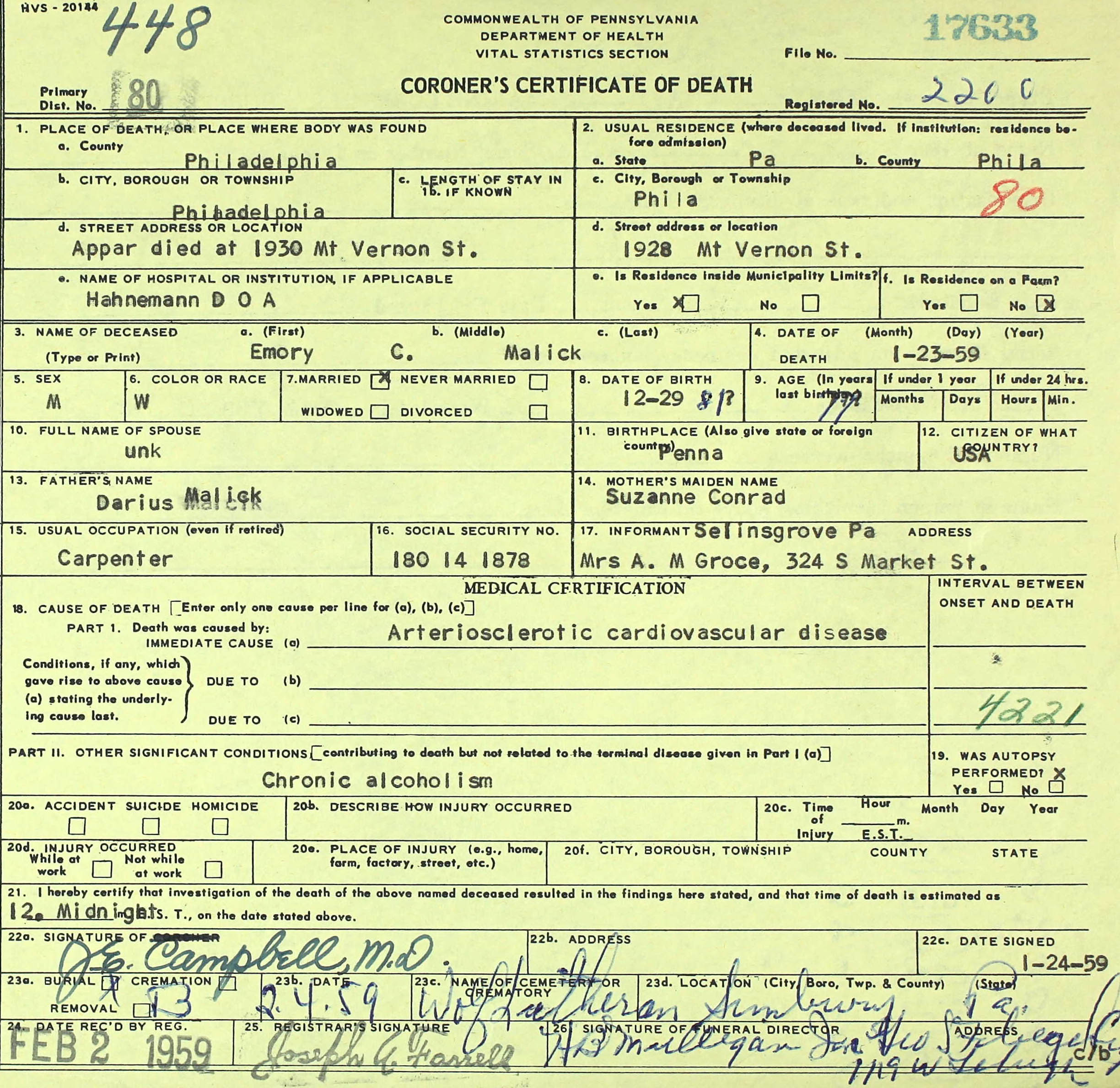
In addition to the above records on Emory and his parents, the following records also reinforce the idea that this family was white (no-non-white records have been found anywhere):
The Sunbury Daily Item on 16 Jun 2013 added the claim that "His Malick ancestors, already of mixed European and African heritage, came to Pennsylvania from Germany in the 1700s." There is no record of any mixed African heritage of the Malick family in Northumberland County. Note, the people of Northumberland County don't care if these pioneers were white or black or members of any other ethnic group. But claims require evidence and all the evidence says the Malick families were white (reference 1790, 1800, 1810, 1820, 1830, 1840, etc US census records as well as modern DNA ethnicity reports).
In conclusion, it seems that Guy Franklin's investigation and conclusion that Emory was more likely white seems obvious. An independent observer would note that there are no indications anywhere in the record to suggest that Emory in particular or the Darius Malick family in general were black or even of mixed black ancestry. One would expect a high standard of evidence for declaring someone to be the First Black anything. Emory Malick does not meet this standard.
This leaves open the question then, who was the first Black Aviator? The answer depends on selection criteria, and this page will not attempt to settle that question. Is the question related to just the United States? Does it depend on licensing credentials? The answer depends upon the details of the claim being made. Note that in the example below that one early aviator, Charles Wesley Peters is unambiguously identified as black at that time in both the newspaper and census records.
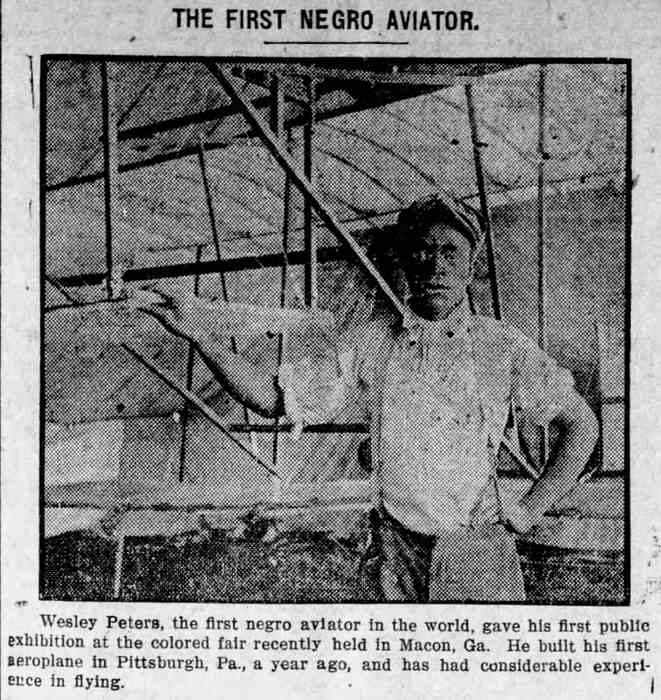

Other earlier black aviation pioneers:
Related links: